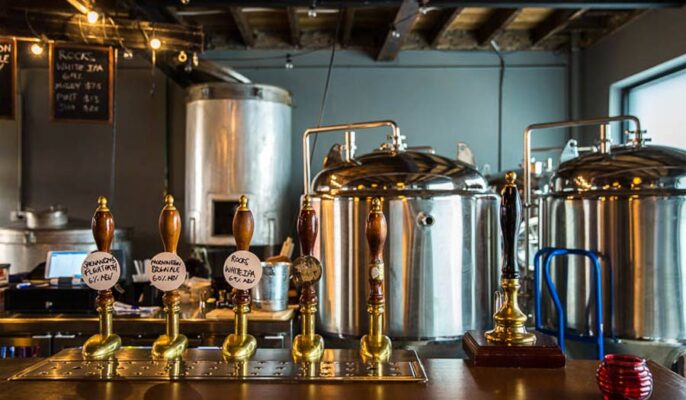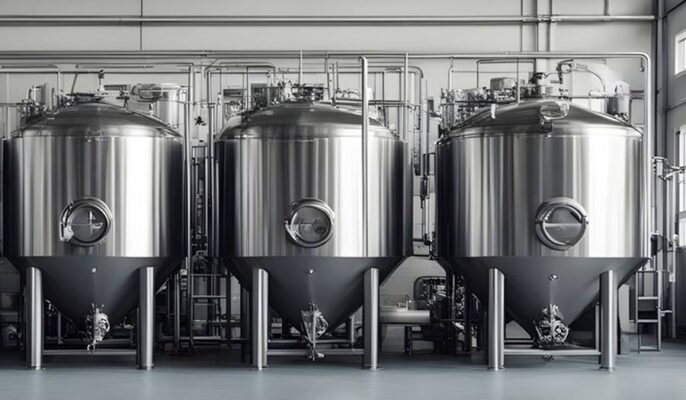Fermentation tanks are a critical component in any brewery. This guide provides craft brewers with a detailed overview of 500L fermentation tank brewery equipment including types, design, process integration, suppliers, costs, and selection factors.
Introduction to 500L Fermentation Tanks
500 liter fermentation tanks enable efficient, consistent beer production at a small to mid-size craft brewery scale. Key features of 500L fermenters:
- Batch capacity around 500 liters or 120-150 gallons
- Optimized for ales and lagers at 5-7 barrel scale
- Shorter fermentation time compared to smaller tanks
- Flexible fermentation temperature control
- Cone or cylinder tank shapes with conical bottom
- Integrated cooling jackets for temperature control
- Made from stainless steel (304, 316 grades)
- CIP cleaning and sanitization
- Automated monitoring and control system
A properly designed 500L fermentation system delivers repeatable beer quality, higher yields, and greater flexibility for various recipes and brewing processes. This guide covers 500L fermenter selection, integration, operation, maintenance, suppliers, and costs.
Fermentation Tank Types
The main types of 500L fermentation tanks include:
500L Fermenter Types
| Type | Description |
|---|---|
| Cylindroconical | Cylindrical tank with conical bottom |
| Conical | Cone-shaped rounded bottom tank |
| Vertical | Tall tank with small footprint |
| Horizontal | Cylindrical placed horizontally |
- Cylindroconical – Most common design provides efficient yeast settling. Cylinder upper with cone bottom.
- Conical – Fully conical tank requires less floorspace but less ideal fluid dynamics.
- Vertical – Tall and slim with reduced diameter, saves floorspace.
- Horizontal – Lays on side, flexibility for low roof brewhouses.
Conical bottom fermenters provide optimal flow for yeast separation and harvesting. Cylindroconical tanks offer a balance of space efficiency and performance.
Craft Brewing Process with 500L Tanks
A generalized craft brewery process flow with 500L fermentation tanks:
- Milling – Grain is milled into grist to create extract
- Mashing – Grist is mixed with hot water and enzymes convert starches to fermentable sugars
- Lautering – Sugary liquid wort is separated from spent grains
- Boiling – Wort is boiled with hops for aroma, flavor, preservation
- Whirlpool – Trub and hops are separated from clear wort
- Cooling – Wort is rapidly cooled to fermentation temperature
- Fermentation – Yeast converts sugars to alcohol and CO2 in the 500L fermenters
- Maturation – Beer rests for flavor development before packaging
- Carbonation – CO2 can be added for bottling/kegging
- Packaging – Final beer is packaged in bottles, cans, kegs
Fermentation Stage
- Yeast is added to cooled wort in the 500L fermentation tanks
- Temperature is maintained for ale or lager fermentation
- Yeast ferments sugars, producing alcohol and flavors
- Duration ranges from 5-15 days based on beer type and parameters
- Yeast settles out in conical bottom for removal
500L Fermenter Design and Configuration
Typical 500L fermentation tank design features:
500L Fermenter Design Elements
- Conical or cylindroconical stainless steel tank
- Integrated cooling jacket for temperature control
- Rotating racking arm for yeast removal
- Bottom yeast dump valve and sample port
- Opening for dry hopping or fruit additions
- CIP sprayball for cleaning and sanitization
- Level and pressure sensors, temperature probes
- Glycol/water chiller system
- Automated monitoring and fermentation control
Configuration Examples
- Single 500L tank – Entry level nano brewery
- Two 500L tanks – Primary and secondary fermentation
- Ten 500L tanks – Larger scale production
- One 500L and several smaller tanks – Pilot batches and experimentation
- Mix of 500L and larger 1000L+ tanks – Mid-size brewpub or microbrewery
Customization and Options for 500L Tanks
500L fermenters can be customized with:
500L Fermenter Customizations
- Conical or cylindroconical tank shape
- Pressure-rated vessels
- Direct steam heating
- Specific material – 304 or 316 stainless, enamel coatings
- Wide temperature range chillers
- Variable speed drives on pumps
- Upgraded automation and controls
- Touchscreen panels, data logging, analysis
- Mobile tank stands or fixed mounting
- Larger yeast dump valves and openings
- Additional sample ports
- Sight glasses and light inserts
- Upgraded racking arms and triclamp fittings
- Higher quality welds and finishing
- Custom painting and branding
Working with a tank fabricator to tailor the specifications to your brewery’s needs and goals ensures optimal integration and performance.
Suppliers and Costs of 500L Fermentation Tanks
Some fermentation tank manufacturers and indicative pricing:
500L Fermenter Manufacturers and Prices
| Supplier | Location | Price Range |
|---|---|---|
| AAA Products | USA | $8,000 – $12,000 |
| JV Northwest | USA | $7,500 – $15,000 |
| Spike Brewing | Canada | $6,500 – $10,000 |
| Ss Brewtech | USA | $7,000 – $14,000 |
| Jupiter | Turkey | $5,000 – $8,000 |
| Riteboiler | China | $4,000 – $7,000 |
- Prices range from $4,000 to $15,000 per tank depending on features.
- Standard stainless steel cylindroconical 500L tanks cost $6,000 to $10,000.
- American and Canadian suppliers generally cost more but provide better quality.
- Imported Chinese tanks are cheaper but have higher defect rates.
- Advanced control systems, accessories, shipping etc. add to costs.
- Large order discounts from manufacturers are possible.
Installation, Operation and Maintenance
500L Fermenter Installation
- Space required with room for airflow and access
- Mounted on stand or fixed into brewery floor
- Glycol chiller hookups and insulation
- Wiring of panels, controls, and sensors
- Pipework connected for CIP cleaning
- Tested for leaks after installation
Operation
- Yeast pitched and fermentation monitored
- Temperature controlled via integrated jackets
- Adjustments to yeast health and fermentation factors
- Cleaning and sanitization between batches
Maintenance
- Inspections and preventative maintenance
- Replacement of worn parts like seals
- Checking and recalibration of sensors
- Passivation and descaling if required
- Records of all maintenance activities
Proper installation, operation, and preventative maintenance ensures optimal fermentation and longevity of the tanks. Staff training is key.
How to Select the Best 500L Fermentation Tank
Key selection criteria for 500L fermenters:
500L Fermenter Selection Factors
- Reputable manufacturer with proven brewery track record
- Quality of stainless steel and welds
- Tank geometry for ideal yeast settling
- Integration of temperature control and monitoring
- Ease of cleaning and sanitation
- Flexibility for fermentation parameters
- Options like racking arms, yeast dump, sample ports
- Cost considerations – import vs domestic
- Delivery, warranties, and ongoing support
- Meets brewery goals for production and beer styles
- Possibilities for future expansion and upgrades
- Reviews and testimonials from other breweries
Consider both technical specifications and supplier relationships and expertise. This ensures a high-quality fermentation system matched to your brewing needs and processes.
Pros and Cons of 500L Fermentation Tanks
Advantages of 500L Tanks
- Optimized batch size for craft breweries
- Flexible temperature control capabilities
- Efficient fermentation and yeast harvesting
- Repeatable results and quality control
- Scalable expansion with multiple tanks
- Cost-effective compared to very large tanks
Disadvantages
- Higher capital cost than smaller tanks
- Additional space required
- More demanding operation and maintenance
- Potential quality issues without proper procedures
- Limitations on extremely high gravity or specialty beers
The advantages often outweigh the downsides for rapidly growing craft breweries. 500L tanks balance production capacity with flexibility.

FAQ
Q: What size craft brewery uses 500L tanks?
A: 500L fermenters are ideal for nano, micro, and brewpub operations doing 5-20 barrel batches. This equates to production of 150 to 600 barrels annually.
Q: How many 500L tanks are needed?
A: For primary fermentation, a brewery will need at least 2-5 tanks for pipeline brewing. Additional units enable lagering, experimentation, and expansion.
Q: What are cylindroconical tanks?
A: Cylindroconical are the most common fermenters which have a cylindrical upper tank and conical bottom tank section. This provides efficient yeast settling.
Q: What material are 500L fermenters made from?
A: 500L tanks are constructed from stainless steel – usually grade 304 stainless. More demanding applications may use 316 stainless or specialized coatings.
Q: How long does fermentation take in 500L tanks?
A: Depending on the beer recipe and yeast, fermentation may take 5 days to 2 weeks. Primary fermentation finishes within 1-2 weeks in most cases. Additional conditioning is often preferred.
Q: Do 500L tanks require cooling?
A: Yes, precise temperature control is critical during fermentation to create clean, consistent beer. Integrated cooling jackets are heated or chilled with glycol or a chiller system.
Q: Are 500L fermenters automated?
A: They can be. Many 500L tanks now include automation of temperature, monitoring, data logging, cleaning, etc. Advanced control is recommended but adds cost.
Q: What maintenance is required?
A: Preventative maintenance involves replacing seals, o-rings, gaskets, lubricating parts, recalibrating probes, checking fittings, and passivation.
Q: Can multiple beer styles be brewed?
A: Yes, with proper cleaning and yeast handling procedures, 500L tanks can ferment various ale and lager styles. Additional tanks provide more flexibility.
Conclusion
In summary, 500L fermentation tanks provide an ideal capacity for efficient craft beer production at a nano or microbrewery scale. Their optimized dimensions, conical design, temperature control, and automation capabilities enable high-quality, consistent fermentation. Working with a quality tank fabricator to integrate a properly designed 500L fermenter system provides a scalable solution to meet craft brewers’ needs.





